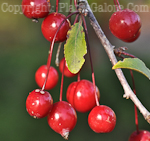|
 |
|
 |
|
 |
|
 |
 |
Three
separate fungal organisms are involved in this disease
which can infect most varieties of eastern red cedar (Juniperus
virginiana), juniper,
apple,
crabapple,
hawthorn,
quince,
mountain ash,
pear and
serviceberry.
|
 |
|
 |
 |
.jpg) The symptoms on the
deciduous hosts begin with yellow spots on the upper
surface of the leaf. In late summer, brownish
clusters of threads or cylindrical tubes appear
beneath the yellow leaf spots or on fruit and twigs.
The spores formed in the threads or tubes infect the
leaves and twigs of junipers during wet, warm
weather in late summer and early fall. The symptoms on the
deciduous hosts begin with yellow spots on the upper
surface of the leaf. In late summer, brownish
clusters of threads or cylindrical tubes appear
beneath the yellow leaf spots or on fruit and twigs.
The spores formed in the threads or tubes infect the
leaves and twigs of junipers during wet, warm
weather in late summer and early fall.
Galls and swellings on the junipers appear about seven
months later and form gelatinous masses of spores after
about 18 months. The rust diseases are very conspicuous
on red cedar and junipers during spring when the galls
are covered with orange-brown, gelatinous masses. Rust
spores formed on the masses cannot infect other
junipers. They infect the twigs, fruit or leaves of the
deciduous host during wet, rainy weather in early
spring.
|
 |
 |
 |
If practical, destroy nearby junipers or prune off galls
in late fall or early spring before
crabapples are in
bloom. Avoid planting susceptible deciduous hosts near
red cedars.
Plant resistant varieties of hawthorns such as the
Washington hawthorn,
Crataegus phaenopyrum.
|
 |
 |
 |
 Fungicides applied as
soon as the foliage opens on the deciduous host will
minimize this infection. Timing is all important since
the spores will be on the leaves as soon as they open. Fungicides applied as
soon as the foliage opens on the deciduous host will
minimize this infection. Timing is all important since
the spores will be on the leaves as soon as they open.
|
 |
 |
 |
|
Some plants resistant to and
susceptible to cedar-apple rust: |
| RESISTANT |
SUSCEPTIBLE |
Juniperus chinensis
- Chinese Juniper
-
'Foemina'
-
'Keteleeri'
-
var. sargentii
J. communis - Common juniper
-
'Aureospica'
-
'Saxalilis'
-
'Suecica"
J.
var. depressa
J. sabina - Sabin juniper
-
'Broadmaar'
-
'Knap Hill'
-
'Skandia'
J. squamata - Single-seed Juniper
J. virginiana - Eastern Red Cedar
-
'Tripartita' |
Juniperus
scopulorum - Rocky Mountain Juniper and
its varieties
J. virginiana - Eastern red cedar
Malus - Apple,
crabapple
HIGHLY SUSCEPTIBLE
APPLE VARIETIES
-
M. 'Jonathan'
-
M. 'Rome'
-
M. 'Wealthy'
-
M. 'York Imperial'
-
M. 'Bechtel'
-
M. 'Parkman' |
A plant that is
resistant to a disease is NOT immune to it. A
resistant plant is still susceptible but is much
less likely to contract a particular disease or may
not suffer as much damage from it if it does become
infected.
|
 |
|
 |
|
Note: We
have provided some general information and
observations on this topic aimed at the home
gardener. Before you take
any serious action in your landscape, check
with your state's land grant university's
Cooperative
Extension
Service for the most current,
appropriate, localized recommendations. |
|



